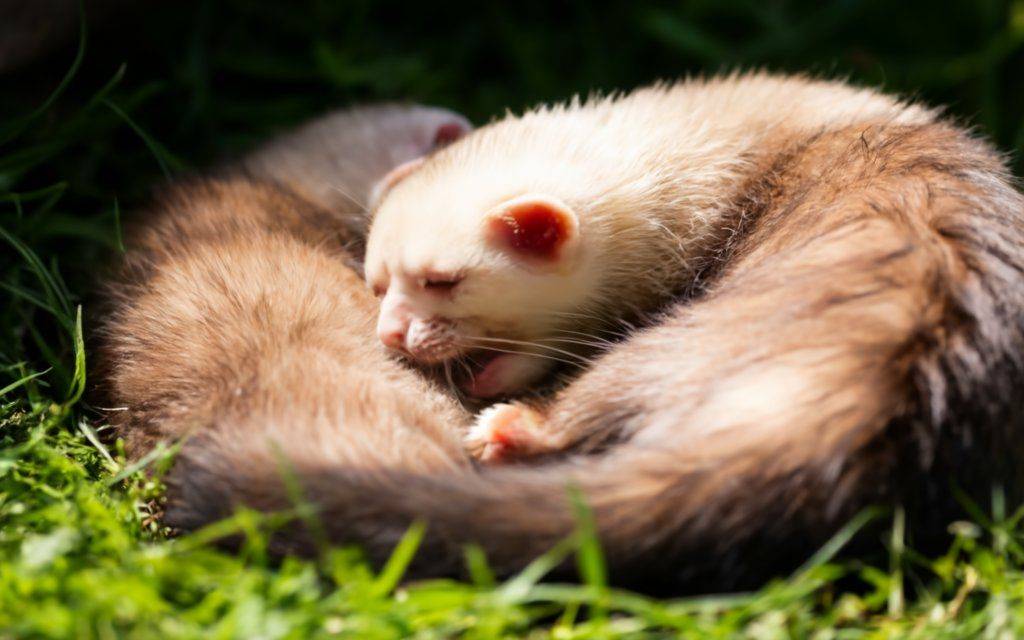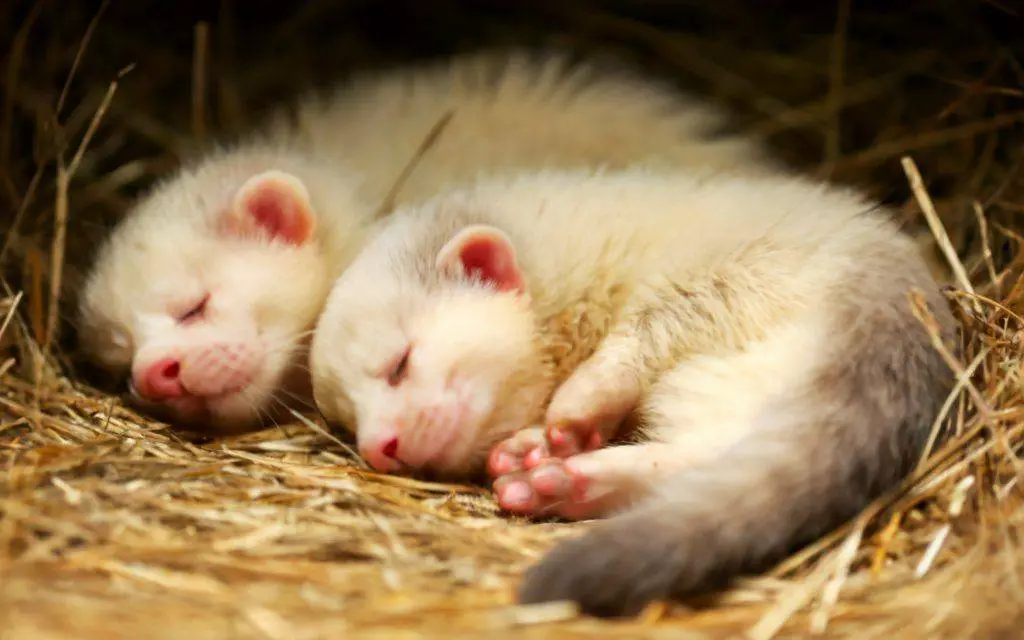
Unlock the secrets of ferret sleep patterns for optimal care. Discover insights into their natural behaviors and habits. Explore a comprehensive guide on ferret sleep cycles, fostering a deeper understanding of your furry friend’s restorative needs.
Ferrets, those playful and inquisitive mustelids, are not just known for their boundless energy but also for their intriguing sleep patterns. Understanding how ferrets sleep is essential for every ferret owner, as it provides insights into their well-being, behavior, and health. In this comprehensive guide, we’ll dive into the fascinating world of ferret sleep, exploring their natural patterns, average daily sleep duration, and the factors that influence their slumber.
Jump To
Natural Sleep Patterns of Ferrets
Ferrets are crepuscular animals, which means they are most active during dawn and dusk. This behavior sets them apart from nocturnal animals, which are active during the night, and diurnal animals, which are active during the day. Understanding the crepuscular nature of ferrets is crucial for creating a suitable environment that aligns with their natural instincts.
In the wild, ferrets exhibit unique sleep patterns dictated by their crepuscular lifestyle. Their sleep is intricately tied to their burrow living, and the safety and security provided by these underground dwellings influence the duration and depth of their rest. Exploring how ferrets sleep in their natural habitat helps us comprehend their sleep needs and adapt our care accordingly.
Average Daily Sleep Duration
On average, ferrets sleep approximately 14 to 18 hours a day. This may seem like an extensive amount of time, especially compared to the sleep patterns of humans. However, it’s essential to recognize that ferrets have a polyphasic sleep-wake cycle, meaning they experience multiple sleep and wake cycles within a 24-hour period.
The sleep-wake cycle of ferrets is characterized by short periods of deep sleep followed by brief periods of wakefulness. This cyclical nature aligns with their crepuscular behavior, allowing them to be alert and active during the times of day when they would naturally hunt and explore in the wild. As nocturnal animals sleep during the day and diurnal animals sleep during the night, ferrets, being crepuscular, adapt their sleep patterns to the dawn and dusk hours.
Understanding the polyphasic sleep-wake cycle of ferrets is crucial for ferret owners. Maintaining consistency in their sleep routine by providing a quiet and secure environment during their sleep hours contributes to their overall well-being. Additionally, being aware of their natural sleep duration helps ferret owners identify potential issues if there are drastic changes in their sleep patterns.

Factors Influencing Ferret Sleep
As with any animal, several factors influence the sleep patterns of ferrets. Understanding these factors is crucial for providing an environment that promotes healthy and restful sleep for your furry friends.
Age-Related Sleep Patterns: Ferrets undergo changes in their sleep patterns as they age. Kits, or baby ferrets, tend to sleep for more extended periods, sometimes up to 20 hours a day. As they mature into adults, their sleep duration typically decreases to the average 14-18 hours. Older ferrets may experience variations in their sleep patterns, and it’s essential to be mindful of any significant changes as it could indicate potential health issues.
Environmental Factors: The environment in which a ferret lives has a significant impact on its sleep. Light and darkness play a crucial role in regulating their circadian rhythm. In their natural habitat, ferrets are accustomed to a certain amount of daylight and darkness, which influences their sleep-wake cycle. In a domestic setting, mimicking these natural light conditions helps maintain a healthy sleep routine.
Creating an ideal sleep environment involves providing a quiet and secure sleeping area. Ferrets prefer dark, cozy spaces for sleep, resembling the safety of burrows in the wild. Placing a comfortable bed or sleeping hammock in a quiet corner of their cage or play area allows ferrets to retreat for rest undisturbed.
Ferret Sleeping Positions and Behaviors
Ferrets exhibit a variety of sleeping positions and behaviors, each conveying different aspects of their well-being and comfort. Observing these positions can offer insights into their physical and mental state.
Common Sleeping Postures: Ferrets are known for their flexibility, and this is evident in the various sleeping postures they adopt. Some common positions include the classic curled-up ball, stretched-out flat, or even on their backs with legs in the air. Each posture may indicate different comfort levels or preferences.
Rolled-Over Sleep and Trust: When a ferret sleeps on its back, exposing its belly, it signifies a deep level of trust and comfort. This vulnerable position suggests that the ferret feels secure in its environment and trusts its owner. It’s a heartwarming display of the bond between the ferret and its human caretaker.
When you understand these sleeping positions, it helps you gauge the comfort level of your pets and identify any potential discomfort or stress. Additionally, recognizing behaviors like twitching or vocalization during sleep allows you to distinguish between normal sleep patterns and signs of potential issues.
Creating a Comfortable Sleep Environment
Ensuring that ferrets have a cozy and secure sleep environment is crucial for their well-being. Here’s a breakdown of factors to consider:
| Sleeping Accommodations | Environmental Conditions |
|---|---|
| Choose suitable bedding, such as soft blankets or hammocks. | Maintain an optimal temperature, ideally between 60-80°F (15-26°C). |
| Provide a variety of sleeping accessories to cater to individual preferences. | Create a dark and quiet sleeping area, mimicking their natural burrow. |
Creating an ideal sleep environment involves understanding your ferret’s preferences and observing their behavior. Some ferrets may prefer hammocks, while others enjoy snuggling in cozy blankets. By offering a variety of sleeping options, you allow them to choose what makes them most comfortable.
Sleep Disorders in Ferrets
While ferrets are generally resilient sleepers, like any animals, they can experience sleep disorders. Here’s a look at common sleep-related issues and potential solutions:
| Common Sleep Disorders | Potential Solutions |
|---|---|
| Insomnia or difficulty sleeping | Ensure a consistent sleep routine and a comfortable sleep environment. |
| Narcolepsy or sudden sleep episodes | Consult a veterinarian for a thorough examination and advice. |
| Excessive twitching or vocalization during sleep | Monitor for signs of distress and seek professional guidance if behaviors persist. |
Understanding sleep disorders in ferrets requires keen observation. If you notice persistent changes in their sleep patterns or unusual behaviors, consulting with a veterinarian is crucial. Addressing sleep-related issues promptly contributes to their overall health and happiness.
Sleep and Ferret Health
The relationship between sleep and ferret health is intricate. Here’s a closer look at how adequate sleep contributes to their overall well-being:
| Impact of Sleep on Health | Promoting Ferret Health Through Sleep |
|---|---|
| A well-rested ferret is more resistant to illnesses. | Ensure a balanced diet and regular exercise to support overall health. |
| Adequate sleep aids in stress reduction and promotes a healthier coat. | Monitor for signs of stress and provide mental stimulation through play and enrichment. |
Recognizing the interconnectedness of sleep and health allows ferret owners to approach their care comprehensively. Providing an environment that supports restful sleep contributes to their physical and mental resilience.
Ferret Napping Habits
Ferrets are known for their adorable napping habits, which often involve short and frequent periods of rest throughout the day. Understanding their napping behaviors adds another layer to comprehending their sleep patterns:
| Characteristics of Ferret Napping | Interpreting Napping Behaviors |
|---|---|
| Short naps of 15-20 minutes, multiple times a day. | Indicates a healthy polyphasic sleep-wake cycle. |
| Playful and energetic bursts between naps. | Reflects their crepuscular nature with bursts of activity during dawn and dusk. |
Ferret napping habits are part of their natural rhythm, allowing them to conserve energy for bursts of playfulness. Providing a stimulating environment during wakeful periods supports their active nature.
Social Dynamics of Ferret Sleep Patterns
Ferrets are social animals, and their sleep patterns often reflect their interactions with fellow ferrets and human companions. Understanding the social dynamics of their sleep is essential for fostering positive relationships:
| Social Sleep Behaviors | Promoting Social Harmony |
|---|---|
| Cuddling and sleeping in piles. | Indicates a strong bond between ferrets. |
| Sleeping in proximity to humans during nap times. | Builds trust and strengthens the human-ferret bond. |
Observing how ferrets sleep together or seek human companionship during naps provides valuable insights into their social needs. Creating opportunities for shared rest enhances their sense of security and connection.
Embracing Ferret Sleep Habits
A ferret’s sleep pattern is a fascinating aspect of their behavior that reflects their natural instincts and overall well-being. As responsible ferret owners, embracing and accommodating their sleep habits is crucial for promoting a happy and healthy life:
| Key Takeaways | Actionable Steps |
|---|---|
| Ferrets are crepuscular, with a polyphasic sleep-wake cycle. | Establish a consistent sleep routine and provide a comfortable sleep environment. |
| Environmental factors and age influence sleep patterns. | Mimic natural light conditions and adjust care based on age-related sleep changes. |
| Recognize and address sleep disorders promptly. | Consult with a veterinarian for professional guidance. |
| Social dynamics impact ferret sleep behaviors. | Foster social interactions and build trust through shared nap times. |
By embracing and understanding ferret sleep habits, owners can enhance the quality of life for their furry companions. From creating a cozy sleep environment to recognizing signs of distress, attentive care contributes to the overall happiness and well-being of these playful and endearing mustelids.